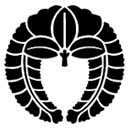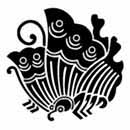Unfortunately, as cool as it could sound, claiming a genealogy from mithology can get quite cloudy, expecially during Sengoku Era, where ancestors and the like got actual political nuanches depending on the situation.
It's important to see how back in the days the historical documents were called yotsugi monogatari ("stories of successions") or gunki monogatari ("Military stories"), the first focusing on how and when a certain family was connected to this or that God who assisted or helped Amaterasu during her shut-in break that much ado caused back in Heaven... From such a premise, you can see how difficult can be tracing the genealogy of a samurai class, and how vague the whole system is, despite its apparent liability: think of cases were a samurai changed his family name whenever he found fit, or how mon and crests were traded during battles or presented by the Emperor or a superior for a nice task.
This post tries to clarify some things about Nobunaga's ancestors, actual or claimed, trying to outline their circumstances.
 Fujiwara clan
Fujiwara clanContrary to popular belief, the Oda Clan, specifically the Ise no Kami branch (also known as "Iwakura Oda", referring to their home castle), used to style themselves as offshots of the Fujiwara Clan, one of the most powerful families of the Heian period (794–1185).
One of the perpetrators that we have evidences of was a certain Oda Michikatsu, who used to sign his orders as "Fujiwara no Michikatsu", implying famous ancestors.
The sources about this theory are quite nebulous, but as an evidence is usually reported the Oki Bumi, a sort of testament left to the Tsurugi temple by Fujiwara Nobumasa and his son Masahiro, who are connected to the Oda because they were appointed as subordinated of one of the clan of Imperial origin, the Shiba, which was exactly the clan that the Oda served before their rebellion.
It's interesting to note that even Nobunaga used this illustrious surname to sign some orders related to the Atsuta village, part of his domain, in 1549, following the tradition.
Anyway it's also due noting that after this document, the signature "Fujiwara no Nobunaga" won't be seen around again.
The symbol of the Fujiwara clan is the fuji-mon, the wisteria, arranged in a descending position, as to remind the prosperity coming down on them from the grace of the Emperor.
To know more about the protagonists and history of this clan, I suggest you to take a peek to their article on SamuraiWiki, without making me summarize the whole thing here.
 Taira Clan
Taira ClanWhat you'll hear more frequently, will be the story about Nobunaga being a descendant of the Taira Clan.
If the Taira Clan is a clan of warriors, so on a lower level than the aristocratic Fujiwara, it's also worth nothing that this was indeed a cool choice for an ancestor.
Nobunaga started to style himself as a Taira's offshot around 1570, an effort to distance himself from shogun Ashigaka Yoshiaki, that used to trace his family to the Minamoto clan, which Taira clan was the most popular and legendary nemesis when it came to Japan's domination.
It was pretty much a strategic move to legitimize himself at the eyes of the Imperial Palace without any actual proof, but at least here Nobunaga could sport a fancy story to come with it: according certain sources, the ancestor of Nobunaga was Taira no Chikazane, who moved to the city of Ota taking its name for security reasons, while trying to escape the erasing of his clan by the Minamoto.
The symbol of the Taira clan is the chou-mon, the butterfly, arranged as a so called "butterfly with rising wings" (agehano chou). The butterfly was popularly recognized as a simbol of grace and elegance.
For further infos on the Taira Clan, go here.
 Inbe Clan
Inbe ClanBesides all the random claims that have been made back in time and have been taken for granted, some recent studies started to investigate further on this subject.
One of the most validated theory is that of Tagaya Ken'ichi that in his Shikaku Zasshi traced the origin of Oda clan to the Shinto priests's clan of Inbe.
The Japanese historian tracked the movements of the clan, originating from Echizen, owners and protectors of the above mentioned temple of Tsurugi, and how it found its way to Owari.
It's nice to see that even the Tairas find their spot in this theory, as the mother of the ancestor of the Oda Clan was of Taira descent.
The symbol of the Inbe was the asa-mon, the hemp leaf, or marijuana.
This kind of symbol was traditionally tied to Shinto priests of that area because it was connected to the production and trade of hemp clothes, and because, obviously, for the effect of marijuana, used during the Shinto rituals.
The debate is still open on the issue but it's interesting to note how in both Taira and Inbe clan, the members were ultimately delegitimated by their arch-enemies, the Minamoto in the first case and the Nakatomo in the second.
--Probably claiming descent from the Fujiwara would have been a luckier pick for Nobunaga!
If you're up for further investigation of the issue, I suggest you to read this article, too, that leans towards the Fujiwara theory and offers some wonderful historical insights. I used it as an information source for the various theories available.
Another credit for this post goes to World of Kamon, where I found the pictures of the emblems of the various clans.
Pfft, stupid me. I just remembered where I read the Inbe ancestry theory from. I just remembered it wrong and thought it was another family.
ReplyDeleteBesides the link at the end of the post, it was also mentioned on the Japonius :D !
DeleteYes, I know! I got confused with "Kanbe", Nobutaka's adopted family. And then I realized I made a mistake. Derp XD
DeleteBy the way, I tried looking up the kamon in the link you give, but I cannot navigate the site. How do I find the list of crests? O__o
ReplyDeleteHere's a direct link to the page: http://www.harimaya.com/kamon/column/index.html
DeleteThe various mon are listed under "CONTENTS", and they are divided by subject, not by clan-- So you had to know what to look for XD
It's really bad organized T_T but it's full of infos! --If I could read it properly, instead of deciphering it randomly XD
I'm a little confused... When looking up the Inbe family, the one supposed to be Nobunaga's ancestor is 伊部. But the one who has the hemp/marijuana crest is written like this 忌部.
DeleteAre they different families? O__o I cannot find a kamon for 伊部 family. This is so strange >.<
No, no, "Inbe" is written as "忌部" and sometimes it's found as "斎部", both their first kanji mean something like "abstinence".
DeleteLook here -> http://ja.wikipedia.org/wiki/%E5%BF%8C%E9%83%A8%E6%B0%8F
This article you linked says it's written 伊部: http://www.odanobunaga.com/familytree.htm O___O
DeleteMmmmmh, I researched the name, and the only time I found it in connection with Nobu is here -> http://www.geocities.jp/syuugoro2/nobu_roots.htm , where is spelled "忌部" in brackets... So I guess that it's again another different spell of 忌部, just like 斎部.
DeleteI found it also on the website of the Tsurugi Jinja, so there may be a connection, but it seems to refer to a location and not a clan, a village included into the temple's precints -> http://tsurugi-jinja.jp/enkaku.htm
Is it possible that members of the 忌部 clan moved to 伊部 village and changed their name according to the village's spelling, and then moved to 織田 village and changed their name again..?
Anyway the "original clan" seems to be that of 忌部.
I found this same website too http://www.geocities.jp/syuugoro2/nobu_roots.htm
DeleteWhy is this thing so confusing :/
It's not really confusing-- You just have to assume that when a clan takes the name of a city/village is because they moved there-- Do as these Japanese historians do, give it for granted, ahahah X'D
DeleteAs I was telling a friend, I guess that so many different theories rose because Nobunaga didn't manage to unify Japan.
Look at Tokugawa's story: it doesn't really have any historical proof behind it, but his Minamoto's heritage is pretty much taken as true.